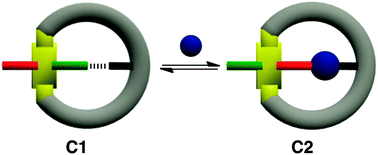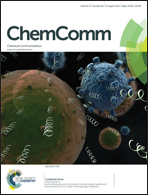A bi-stable Pt(ii) based molecular turnstile†
Abstract
Playing with the competition between H- and coordination-bonds, a bi-stable unsymmetrical organometallic turnstile was designed and its dynamic behaviour was studied in solution using NMR techniques. The turnstile, bearing two differentiated interaction sites, is based on a stator, composed of a square planar Pt(II) centre equipped with one pyridyl group and one phenol moiety, connected to a symmetrical rotor bearing a pyridyl unit as either a H-bond acceptor or as a monodentate coordinating site. Whereas in the absence of a metallic effector, the turnstile is locked by a H-bond formed between the phenol moiety located on the stator and the pyridyl group of the rotor, in the presence of Ag+ cations, the turnstile switches to another closed state resulting from the simultaneous binding of the cations by pyridyl units belonging to both the stator and the rotor. The switching process was shown to be reversible.


 Please wait while we load your content...
Please wait while we load your content...